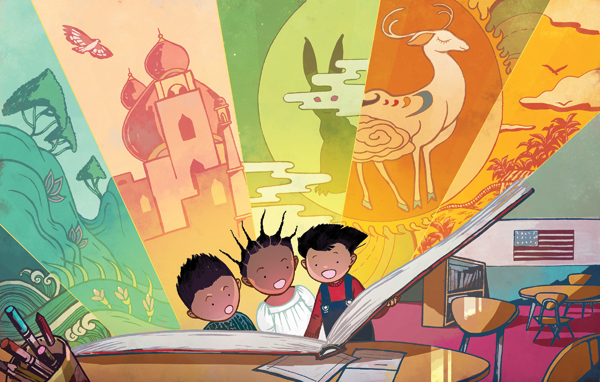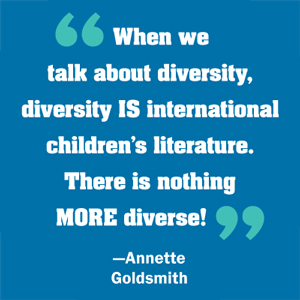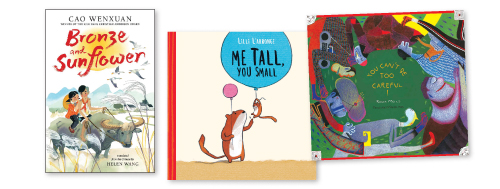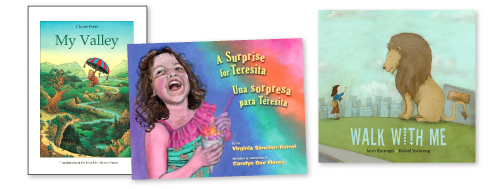Outlandish: Braving new perspectives through books in translation

Illustration by Yao Xiao
In this article:
Here’s a fun trivia question for you. Putting aside the fact that these are written works for children, what do Pippi Longstocking, the Moomins, many of the books by Cornelia Funke, Press Here by Hervé Tullet, and the works of Hans Christian Andersen and the Brothers Grimm all have in common? If you said every one of these was a work of translation, you have earned yourself a cookie. It should come as no surprise to many of us that quite a few classic books for kids that we treasure and love originated in other countries.
Follow-up question, since you’ve done so well: How many translated books for children, besides these aforementioned rock stars, have you read in the last year? Don’t be ashamed if your answer is surprisingly low. Even finding a translated title for children these days can prove a challenge. Most are ineligible for winning any awards but the Batchelder Medal for translation at ALA’s Youth Media Awards.
Yet now more than ever it is imperative that children read books that reflect our globalized world. We’ve heard a lot about needing more diverse books for children, and it’s true. All of it. But the fact of the matter is that talking about diverse children’s books goes above and beyond the familiar. Sure we need windows and mirrors, but don’t those windows need to look out at something besides our own backyards? We want our children to be responsible global citizens, but what does that even mean? And how do you go about growing a deep and abiding appreciation for other cultures in kids? More often than not, American children do not have access to different voices from around the world unless they are reading those voices in translation.
That said, translated children’s books aren’t literary spinach we should be forcing down the gullets of our youth. We’re talking about fun, fantastic, amazing, beautiful books that open eyes, hearts, and minds! When we deny our children these great books from the rest of the world, we are cheating them. For many kids, the idea of traveling the world is only for the privileged. With books you have an ersatz replacement, but only if they’re intentionally brought to kids. “I think we overdo books as mirrors and underemphasize books as windows,” adds author and educator Marc Aronson. “A translated book is precisely a window into another way of thinking and seeing.” And when we miss out on seeing the world through the eyes of someone who is actually from that country, we deny ourselves the chance to experience a culture from within a story.
If reading translated works of literature from around the world is so imperative, then this begs the obvious question: What are the factors preventing American children from hearing stories that come from other nations around the world?
Dispelling otherness
One of the greatest roadblocks is also the most basic: Many Americans simply don’t care if they or their children read stories from other nations. Some of this is simple ignorance, but there’s a darker tendency for Americans to reject books that strike us as different from what we’re used to. When I served on New York Public Library’s 100 Books for Reading and Sharing list committee for almost a decade, every year I would listen to my sophisticated, worldly children’s librarians discuss translated books for kids and try to explain their deep-seated discomfort. “I don’t know why I don’t like it, it’s just not my style.” “I really don’t get what’s going on here.” “It’s weird.”
Whence this knee-jerk rejection? Bookstore owners Jeff Garrett and Nina Garrett of Bookends and Beginnings in Evanston, IL, spend a great deal of time finding and selling foreign and translated children’s literature titles and face this issue regularly. As Garrett says of Americans, “we’re great backers of multiculturalism, but draw the line when we fear that strange values, strange attitudes toward adults or children, non-Westernness in all of its forms and colors, is being imparted. And if we do read picture books about other countries, they are preferably those that have been processed by American storytellers. Foreign books face a reluctance that starts with parents and teachers and is then passed on to children. (Remember our word outlandish and what it literally means.)”
This becomes all the more pronounced when the books in question hail from countries that aren’t in Europe. In the United States, books that receive translations are often overwhelmingly European. Why is this? The answer is multipronged.
In 2011, I attended the Bologna Book Fair, the international event where the foreign rights for children’s books are bought and sold from (that year) 65 different countries. While surveying the conference floor, I noticed to my astonishment that global representation was a spotty affair. Africa, for example, was poorly represented, since publishing in the continent can prove uneven. As children’s literature scholar Leonard Marcus put it, “In some places it does not exist or only barely exists. Picture books for francophone Africa tend to be published in France for distribution in Mali, Senegal, and elsewhere. But plenty of South African children’s books have been published in the U.S.” As for Latin American countries, Mexico, Argentina, and Colombia have, what Marcus calls, “vibrant publishing scenes,” best exemplified at the annual Guadalajara Book Fair. Asia fares better as American publishers are already comfortable with Japanese, Taiwanese, and Korean publishing, and there’s an increased interest in China. “The country I’m most curious to know more about is India,” says Marcus. “I have a feeling we will be hearing a lot from India in the next few years.”
 Indian literature is nothing new to V. Geetha, editorial director of Tara Books. Tara Books was originally founded 21 years ago at a time when there were few fun picture books for kids in India, let alone by Indian authors and artists in America. Reflecting on the challenges the company has faced in the States, Geetha says that, “Oftentimes, non-European texts are slotted into specialist and ethnic categories—and the danger here is to conceive of the universal in limited, rather Euro- and Anglo-centric ways.”
Indian literature is nothing new to V. Geetha, editorial director of Tara Books. Tara Books was originally founded 21 years ago at a time when there were few fun picture books for kids in India, let alone by Indian authors and artists in America. Reflecting on the challenges the company has faced in the States, Geetha says that, “Oftentimes, non-European texts are slotted into specialist and ethnic categories—and the danger here is to conceive of the universal in limited, rather Euro- and Anglo-centric ways.”
Lest we forget, there are practical problems facing children’s book imports. Getting a quality translation in the first place is difficult, since the average U.S. press rarely has employees on staff with the knowledge and ability to vet literature in other languages. Translated titles can straddle categories or age groups, making them hard to categorize in libraries and bookstores. Rachel Hildebrant, a literary translator and founder of Weyward Sisters Publishing, adds that “there’s not [a] systematic way to do it. They [the publishers] have to hire out a report. If we’re talking small indie presses, you have to hire a translator and then figure you can make back the investment. The benchmarks are really high.” Also, as Marcus points out, “Americans generally don’t recognize the value of exposing their children to books from abroad that U.S. publishers perceive to be a hard sell. There are practical issues as well: the difficulty of judging the merits of a manuscript in an unfamiliar language; the cost of translation, the cost of bringing an author or artist here for promotional tours, etc.” The result is often that the only way for readers to find translated titles is to go the extra mile and seek them out on their own.
How often that happens is questionable. After all, since the 2016 presidential election, America has seen a sharp spike in nationalism. As Jeff Garrett says, “It’s somehow very poignant that just as I am writing this to you, at this very moment, we are living through one major result of American obliviousness to foreign cultures, namely the ignorant sealing of our borders to whole groups of foreigners. One is always suspicious of what one doesn’t find familiar. And to prevent this from happening, it’s best … to get books from other countries into the hands of our own children. Because it sows the seeds of mutual respect and mutual knowing.”
To make the “other” recognizable, not just to children, but to teachers and librarians, is to work with translated literature. As we raise the next generation of readers, we must work to help them be open to the world. To do this, they need to hear world voices and to see alternatives to their own way of life. In the end they may still value their own country, but learning about other cultures, straight from the horse’s mouth, adds a richness to their perspectives. Basically, that’s how you create a global citizen. Or, as Annette Goldsmith, coauthor of Reading the World’s Stories: An Annotated Bibliography of International Youth Literature, says, “When we talk about diversity, diversity IS international children’s literature. There is nothing MORE diverse!”
A call to arms
Since the election of President Donald Trump, many social activists have wondered what they can do personally to make the world a better place. For author Aronson, who teaches a class on international children’s books at Rutgers University, the answer is clear: We need teachers and librarians to embrace translated children’s literature. It is not uncommon for children’s books from other countries, particularly those that have been translated, to get short shrift from our literary gatekeepers. Says Aronson, “it is far easier to get an MLIS without ever having read a translated children’s or YA book—other than The Little Prince or Anne Frank: Diary of a Young Girl (neither of which are ever seen as examples of translated books)—than it is to be exposed to this literature.”
How do we make a change? Marcus suggests joining USBBY and attending conferences, but even before that, consider making a list of relevant books in your library’s collection or creating a display or special shelf of translated titles. “The goal should be to make books from elsewhere seem less about ‘foreignness’ and more about the adventure of seeking experiences beyond the bounds of the part of the world we already know.” Hildebrant concurs and offers a variety of additional suggestions. School librarians could pull and highlight titles to accompany world geography studies, international holiday celebrations, and already existing foreign language programs. Public librarians, meanwhile, have the ability to celebrate the languages taught in the local school districts with displays, storytimes, programs, bilingual reading groups, and more.
Finally, consider taking to heart National Ambassador of Young People’s Literature Gene Luen Yang’s recent Reading Without Walls Challenge (geneyang.com/the-reading-without-walls-challenge). In May 2016, he introduced an initiative that challenges people to read a character who doesn’t look like you or live like you, read about a topic you don’t know much about, and read a book in a format you don’t normally read for fun. Global children’s literature is a perfect fit for this experiment. Even if you’re not quite ready to join an organization or put together a display, the very act of reading a book can be an act of resistance.
So don’t be shy! Pick up a work of translation! Give it a read! You might just discover that your next Pippi, Moomin, or Ugly Duckling has been out there waiting for you all along.
A World of Resources
 Books
Books
Give Your Child the World: Raising Globally Minded Kids One Book at a Time by Jamie C. Martin (Zondervan, 2016).
Crossing Boundaries with Children’s Books edited by Doris Gebel (Scarecrow, 2006).
A World of Books in Translation (Riveting Reads) by Daniel Hahn and Joy Court (School Library Association, 2017).
Reading the World’s Stories: An Annotated Bibliography of International Youth Literature By Annette Goldsmith, Theo Heras, and Susan Corapi (Rowman & Littlefield, 2016).
Periodicals
Bookbird: A Journal of International Children’s Literature (ibby.org/bookbird) published quarterly by International Board of Books for Young People.
Words Without Borders: The Online Magazine for International Literature (wordswithoutborders.org) promotes cultural understanding through the translation, publication, and promotion of the finest contemporary international literature.
Online resources
The Outside In A UK website looking at translated books.
The International Children’s Digital Library
Global Literature in Libraries A blog that focuses on a different language each month.
The Mildred L. Batchelder Award
#WorldKidLit September is World Kidlit Month!
Guadalajara Book Fair Exhbitors book catalog.
Articles
“Of Translations and Tarantulas: What’s at Stake When American Children Read Books from Other Countries” by Jeffrey Garrett in Crossing Boundaries with Children’s Books, edited by Doris Gebel (Scarecrow, 2006).
“Global Kids Connect: A Further Look at Issues and Trends for Children’s Publishers” by John Maher, Publishers Weekly, Dec. 13, 2016.
“Outstanding International Books: Presenting the 2017 USBBY Selections” by Holly Johnson, SLJ, Jan. 30, 2017.
“Kids Need Translations—An Idea Whose Time Has Come” by Annette Goldsmith; ALSC Blog, Aug 17, 2016.
“The Sayings of Chairwoman Ursula: ‘Dear Genius’ Goes to China” by Leonard Marcus, Publishers Weekly, Sept. 11, 2014.
“Taipei Book Fair 2017: Children’s Titles, Especially Translations, Are Big Deals” by Teri Tan, Publishers Weekly, Feb. 9, 2017.
Events
Going to the ALA conference in Chicago this summer? Check out the pop-up presentation “The World at Your Fingertips: How to Use Global Literature Translation in Library Programs.” Presented by Rachel Hildebrandt, Annette Goldsmith, Heather Lennon, and Robin Gibson.
Recent releases
 Bronze and Sunflower by Cao Wenxuan, translated by Helen Wang (Candlewick).
Bronze and Sunflower by Cao Wenxuan, translated by Helen Wang (Candlewick).
Me Tall, You Small by Lilli L’Arronge, translated by Madeleine Stratford, illus. by author (Owlkids).
You Can’t Be Too Careful! by Roger Mello, translated by Daniel Hahn, illus. by author (Elsewhere).
 My Valley by Claude Ponti, translated by Alyson Waters, illus. by author (Elsewhere).
My Valley by Claude Ponti, translated by Alyson Waters, illus. by author (Elsewhere).
A Surprise for Teresita/Una sorpresa para Teresita by Virginia Sanchez-Korrol, translated by Gabriela Baeza Ventura, illus. by Carolyn Dee Flores (Arte Público).
Walk with Me By Jairo Buitrago, translated by Elisa Amado, illus. by Rafael Yockteng (Groundwood).
RELATED
The job outlook in 2030: Librarians will be in demand
The job outlook in 2030: Librarians will be in demand
ALREADY A SUBSCRIBER? LOG IN
We are currently offering this content for free. Sign up now to activate your personal profile, where you can save articles for future viewing






Add Comment :-
Comment Policy:
Comment should not be empty !!!
Tina Wissner
This article is a gift! Thanks Betsy:)Posted : Jan 03, 2018 08:38
Judy Goldman
Bravo, Betsy! Well said! Kids in Mexico get to read many books in translation. Rights are bought from the US, India, China, Israel, Korea, and many others, which gives them a whole different perspective. Some of those books are also in the Ministry of Education's reading program. Hopefully, books from Mexico and all those other countries will someday be available in the US.Posted : Apr 06, 2017 10:03
Avery Fischer Udagawa
Thank you for this article! Translated books for young readers is clearly an idea whose time has come. Here is a moving, 15-minute talk on this subject by Daniel Hahn on BBC Radio 4. http://www.bbc.co.uk/programmes/b04hyyr0 Also, for translators of children's literature who seek community, SCBWI has a Translator member category and offers a listserv (worldwide) focused specifically on kidlit translation: SCBWI Translation. To learn more, please email me at itc [at] scbwi.org. Thank you again! Best, Avery Fischer Udagawa SCBWI International Translator CoordinatorPosted : Apr 04, 2017 08:55